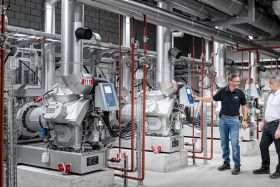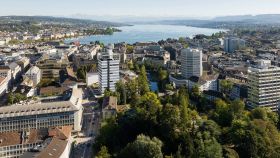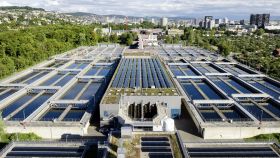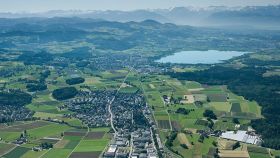
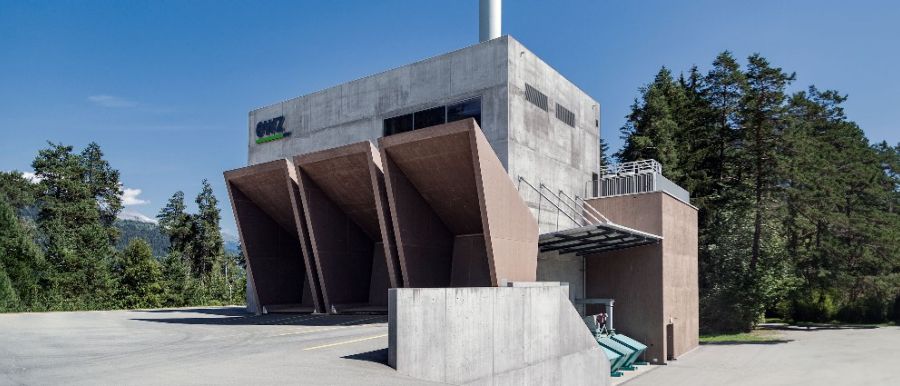
The planning and construction of the wood-fired combined heat and power plant and the district heating network took a total of three and a half years. Construction work began in March 2014 – the first heat was supplied in October 2014. Connecting several large heating customers and public buildings enables the heating network to be operated efficiently.
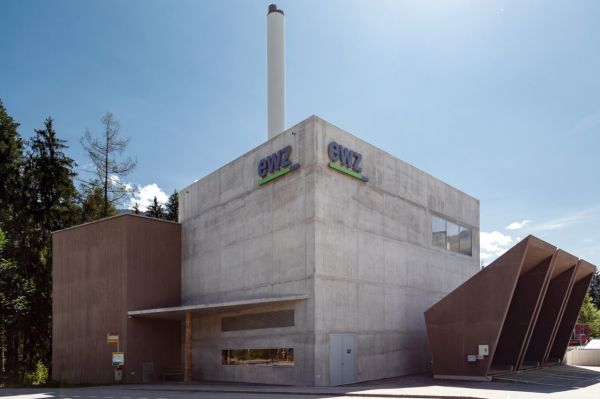
We connect properties throughout Switzerland to district heating and cooling networks. Check whether a connection is possible at your location and find out about the respective prices.
The Ilanz wood-fired combined heat and power plant is designed so that at least 30 per cent of the wood fuel is natural wood chips and the remaining 70 per cent is waste wood. The waste wood comes from the Ilanz region and the wood chips from the forests around Ilanz. In 2019, a total of 27,640 m³ of wood was utilised. Deliveries to the plant were made by lorries of 40 m³ each. The pre-chopped wood is tipped directly from the lorry into one of the three unloading stations and is then automatically stored in a silo. It does not require a drying process.
Producing heat and electricity from wood
The wood-fired combined heat and power plant consists of an intake station and a silo, a wood-fired boiler with a total output of 2,200 kW, an oil-fired boiler with output power of 5,000 kW (as redundancy for peak loads), an ORC (Organic Rankine Cycle) system of 350 kW and a complex filter system for flue gas cleaning.
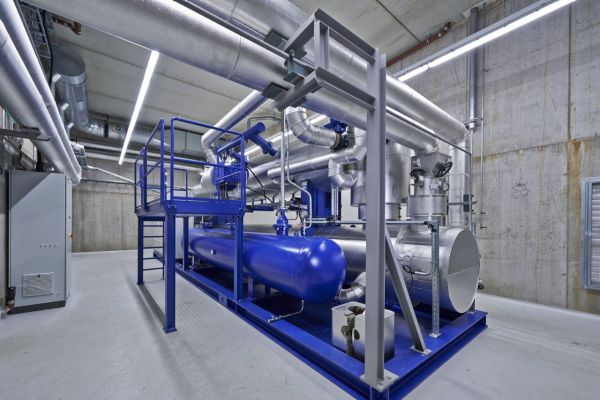
Process for generating electricity and heat
Every three to six minutes, a sliding floor transports wood chips and waste wood from the silo to the combustion furnace. The furnace was built using about seven tonnes of bricks, which allows high temperatures of up to 700 °C and makes it an ideal storage location. The smoke produced during combustion reaches temperatures of up to 700 °C.
The hot smoke is directed from the furnace to the thermal oil boiler, which serves as a heat exchanger. From there, the 310 °C heated thermal oil flows to the ORC system. This is equipped with a turbine and a tank containing a petrol and diesel fuel mixture. The flowing thermal oil heats the petrol mixture and evaporates. This steam drives the turbine, which generates electricity. The vapour is then liquefied again in the condenser and driven via a pump back into the vaporiser as a liquid. The cooling process in the tank heats the district heating supply water, which flows to the connected buildings via the distribution grid.
The resulting flue gases are purified by a unique and complex filter system, meaning that the requirements of the Swiss Federal Ordinance on Air Pollution are fully complied with.
The system is fully automated and monitored by several sensors. One of our specialists is on site every day to monitor and check the system and deal with any fault reports.
Ilanz district heating network
The heat generated from burning the wood is used to heat the district heating water. The wood-fired combined heat and power plant supplies heat to more than 80 local institutions, companies and private individuals. Major customers include the Surselva regional hospital, the care and nursing home, the church hall and municipal buildings such as the town hall and the school.
Thanks to the use of wood as an energy source, at least 80 per cent of the heat is produced in a carbon-neutral and sustainable way. This saves 620,000 litres of heating oil. The wood-fired combined heat and power plant also produces around 1,800 MWh of green power per year, which is equivalent to the electricity requirements of around 360 households. Peak load in winter and heat demand during inspections are covered using heating oil. There is potential for expanding the district heating network.
The Ilanz plant is a successful example of the combination of sustainable energy production and local added value in the form of new jobs. By using waste wood and wood chips from the Surselva for heat and power production, imports of fossil energy are reduced and greenhouse gas emissions are reduced. At the same time, we are supporting the production of renewable electricity. The use of local waste wood reduces transport distances and traffic volumes. Another positive effect is that the use of wood as the main fuel minimises the medium and long-term price risk of purchasing traditional fossil fuels.
For individual customers, connection to a heating network is a safe and efficient way to heat their buildings. They no longer need a boiler room or have to worry about chimney cleaning, measuring exhaust gases or ordering heating oil. They receive the required amount of heat at a fixed energy price, which consists of a monthly basic fee and a fee based on the heat actually consumed. This makes their heating costs predictable and prevents the surprises that could occur when using oil or gas.
With a connection to the Ilanz heating network, we supply you with renewable energy for heating and the generation of hot water.
The following variants are available:
Connection and energy supply
- Connection of your property to the district heating network
- Supply of district heating
Preparing for the connection
- Preparing for the connection of your property to the district heating network
- Supply of district heating at a later date, e.g. when replacing a heating system
We bear the financial and technical responsibility. You pay for the volume of energy purchased and the output power.
We monitor the supply to your property around the clock. You benefit from troubleshooting free of charge.
We supply you with heat from local renewable energy sources. They meet all legal requirements.
The price is made up of three components:
- Connection price: one-off set-up costs
- Price for heating: your consumption-based energy costs
- Base price: costs for infrastructure, servicing and maintenance as well as for the 24-hour on-call service
